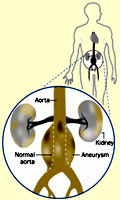|
|
|
The Scary Truth
About Aneurysms 18,000 Americans fall over dead each year, killed by a burst aneurysm. You can avoid becoming one of them. Here's how: (1) learn the facts about aneurysms (2) get screened, and (3) make some smart lifestyle choices. What's an Aneurysm? It's a ballooned out section of a blood vessel. While it's bad news when a major artery busts anywhere in your body, most fatal aneurysms occur in the abdomen and chest, when a thinned, weakened section of the aorta gives way. The popular notion is that an aneurysm is a bolt from the blue, striking rarely, suddenly, and indiscriminately. The truth is that most lethal types (such as those in the aorta) develop slowly, over a period of years, are easily detected by a relatively inexpensive ultrasound test, and can often be successfully treated. Unfortunately, most are never diagnosed. More people die from bursting aortas than from AIDS and brain cancer combined. If you add in cerebral aneurysms, which are usually labeled strokes, the death toll (32,000 lives ended) exceeds prostate cancer and approaches breast cancer (41,000 deaths annually in the U.S.). Why then has this medical problem received so little attention, especially compared to high profile diseases like cancer? Sadly, most people with aneurysms exhibit no symptoms and don't even know they are at risk. Then, when the vessel bursts, these unfortunate folks usually end up dead or severely disabled. As a result, there is no large organized group of patients motivated to raise awareness and funds for screening. There is no national effort to screen for aneurysms before they rupture. The ultrasound test is not normally covered by health insurance companies or Medicare, even when a family history of aneurysms exists... and most doctors fail to even ask about those histories. That's why I paid out of pocket to get an abdominal ultrasound test. The test cost several hundred dollars here on expensive Long Island. That brings up a larger issue. Screening for a potentially fatal aneurysm is a "social dilemma." As a matter of public health policy, it doesn't make "economic sense" to screen everybody. The total cost of screening everyone is far higher than treating those who fall victim to a burst aorta. I don't know about you, but I'm not comfortable rolling that pair of dice. Even though the majority of aneurysms never burst, when they do, the survival rate is only 10%. Most people never reach the hospital alive. On the other hand when a large aortic aneurysm is detected and operated on, the survival rate exceeds 95%. As you probably know, the aorta is the very large artery that extends down from your heart to your lower abdomen. Most deaths (15,500) involve the abdominal portion, which is "fortunate" because a bulge there can be detected easily by the ultrasound procedure. The remainder of aorta-aneurysm deaths (2,500 or about 7%), occur higher in the chest, where a CT scan is required for visualization. A thoracic CT runs about $1,000 to $1,500 in my neck of the woods. I didn't spring for it. Aside from the cost, cat scans frequently show false positives. My stress level is high enough these days without hearing the doctor say, "We saw something. Won't be sure what it really is until we cut you open…" A normal aorta ranges in size between 1.6 and 2.8 centimeters in diameter (about half an inch to a full inch across). Conventional medical wisdom calls to watch closely when any section becomes wider than 4 centimeters (an inch and a half). At 4 centimeters, most aneurysms are still "stable," and do not require immediate surgery. However, when any spot grows wider than 5.5 centimeters (two inches in diameter), surgery is usually indicated. About 50,000 people go under the knife for this procedure in the U.S. each year. The surgery risk is non-trivial (single-digit mortality rate), but still much lower than the death rate from burst aneurysms. The fix usually involves replacing the ballooned-out region with a plastic or fabric tube, although there now is a minimally-invasive alternative which threads a stent-graft into the affected vessel. Our final topic of discussion concerns lifestyle. If you have high blood pressure (above 140/90), you now have another reason to lower it via dietary changes, exercise, and medication. High blood pressure raises your risk of both developing an aneurysm in the first place, and of worsening an existing one. (High blood pressure also doubles your risk of having a stroke.) If you pump iron, especially if you lift heavy, it may make sense to spring for that CT scan. If you've got an aneurysm, heavy straining could pop it, making for a very dramatic afternoon in the gym… Be especially vigilant if you're a man. 80% of burst aortas occur in men over the age of 60. Other factors working against you: smoking and arteriosclerosis. If you smoke, stop. If you've been warned you're at risk of a heart attack or stroke, add a third thing to worry about… |

